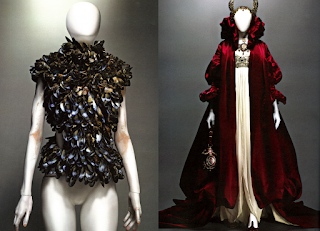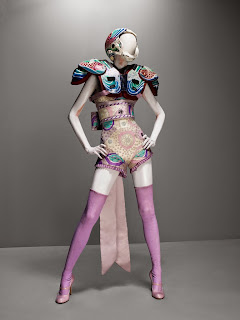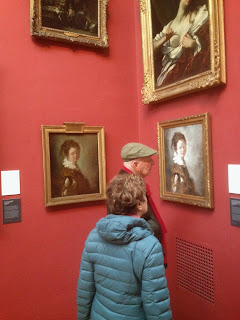 |
| Victoria & Albert Courtyard. watercolor |
Today we decided to visit the spectacular Alexander McQueen exhibition at the Victoria&Albert Museum:"
Savage Beauty". This is without a doubt the exhibition of the year in London where it returned after a successful run at the Met in New York. Ever since museums discovered fashion sells tickets, they have had a field day ordering mannequins and displaying the likes of Gaultier, Yves St Laurent, Vivienne Westwood and many others. Fashion allows for theatrical displays, multimedia madness and colourful crowds.
I like fashion, I think it's cool but it doesn't keep me awake at night. I certainly subscribe to the idea that 99% of it is either bonkers, or just silly. In short, I didn't expect an impact. It did actually have one but not because of McQueen's tragic death or anything particularly deep about the guy. It was just very well done. As a matter of fact the least theatrical of all rooms, the second, was the one that got my wheels whirring. These are my impressions about the show and the clothes themselves:
Very briefly, the exhibit follows a chronological scheme with every new room evoking the environment of McQueens' work and runway spaces at that stage of his career. The first room, for example, displays the low budget designs of a young taxi driver's son with lots of creativity. The environment is industrial-warehouse and the soundtrack -yes, fashion shows have soundtracks- is that of a muffled rave. His designs are inspired by the street, the club-scene, movies and very much by London. McQueen's work shows consistency from his very first stitch not only formally but also from a narrative point of view. He is very much an English designer down to his fetishism of birds, Hitchcock anyone?
The second room shows his MA project as well as his apprenticeship work in Savile Rd. and other places including a workshop that made uniforms. Flawless tailoring takes over. McQueen proves here that to break the rules, you need to know them. The construction of the suits and dresses is original, playful, almost like origami in some cases...one can sense the confidence of a craft well absorbed and ready for the jump into art.

So what's a young gay guy to do with all that power under his scissors. The next room is invaded by romanticism and Gothic influences, it's operatic and baroque, barely edited.There is a sexuality and a power to it no doubt but except for a few details and signature forms, it seems it all has been done before. I like that he is deliberate in his avoidance of women and girls as naive or soft. These are some dark queens, full of armor and sharp edges while wonderfully feminine. He accelerates the appropriation of elements from other arts with prints, plumage and embroidery .

Then begins a series of juxtapositions, the first one being the natural world versus man. McQueen seems to have had a very keen sense of the fragility of life and its savagery. The environment is cavernous and simulates a crypt made of bones and skulls. I believe along with the curators that London is essentially where this idea of the fragility and combat of life is materialized. It's an anarchic place at its core. The design becomes bold and tribal. The materials start to expand into the unheard: hair, horns, skulls,polyester. Had he lived longer, McQueen would surely have won an Oscar at some point.
 |
| "As a place of inspiration, Britain is the best in the world. You are inspired by the anarchy in the country" |
With the next rooms, we are definitely in the presence of a master designer. He draws inspiration from his Scottish roots to create the "
Widows of Culloden" and the show forcefully pairs the seductive tartans against the fairytale designs of "
The girl that lived in a tree" (2008) collection which is inspired by Victorian and romantic English designs. I have no doubt that McQueen felt and loved his Scottish heritage very deeply and that he created a sort of indictment of ancient genocides. However, anybody that thinks for a minute that 'fashion cares' is delusional. Even the designer himself was aware of the inherent contradiction of creating excess while advocating a return to less consumerism, luxury while using cheap materials and so on. From here on, AMQ seems to be "in search of a cause" but it is mostly just a thin thread to hold together his own ideas avalanche.

As if aware of the risk of a flood of photographers (and sketchers) or worse, selfie-stick holders, snapping pics is strictly forbidden. The guards enforcing this rule are polite but unlike in any other exhibits, they are not distracted students or bored to tears matrons. These are tall strapping hawks. Hence no pics. Well, one. My husband has seen the show three times already -thanks god for that V&A membership! and he won't be deterred.
The middle room is amazingly built as a giant curio cabinet holding hats, corsets, bonnets and all kinds of magnificent shoes and jewelry. Here we see the collaboration between AMQ and other designers of accessories like milliner Phillip Tracey or jewel designer Shauna Leane. He teamed up with an ever increasing set of trades like taxidermists, wood carvers and even 3d printers (is that a job yet?) The designs in this room put to shame most contemporary artists and sculptors, each one a tastefully displayed piece, a masterwork in its own right.Videos of his runway parades are projected now full throttle. I think my favorite piece must have been a top made entirely of mussel shells. The idea alone is much better than the result but when you learn to appreciate the jasper beauty of a humble mussel, well , I sympathize with a designer that wants you to wear it. I liked it better than the coral peacock and the bird of paradise - the whole bird- bonnet owned by some countess Bismark or other.

In the middle of the cabinet of curiosities room, a dress
spray painted by robots. In the next room, a holographic Kate Moss
frolics midair in her billowing wedding dress like a mermaid in a dark and pyramidal fishbowl.
The next few rooms are dedicated to his take on the Western versus Eastern styles with some breathtaking kimonos and surprising combination of what by now are McQueen signature ingredients: powerful shoulder pads, elongated bodies by means of lowering the waistlines to the upper thighs, shrouded shoulders, swollen hips, magnificent hats and shoes, etc.. . If you are in London, the Tate gallery is simultaneously exhibiting some photographs on the creation of his "Horn of Plenty" show. It's worth taking a look (and you can take a peek at Tracy Emin's putrid bed and draw your own conclusions about art, life and depression as a creative force, or something.


The exhibit draws to a conclusion with the last show before his untimely death - he hanged himself and let's face it, he must have been exhausted living in "his" world and allowed to roam it. "Plato's Atlantis" is about a world submerged by global warming where apparently we have evolved into incredibly chic survivors, drowned but stylish nevertheless. His animal prints and slick designs seem a lot more wearable all of a sudden. His shapes seem to arrive at a resting state, much more edited, hinted.
In conclusion: A show any artist of any discipline would enjoy. A temple to appropriately worship at the (silly or not, your choice) altar of fashion and romantic notions of genius. There is no doubt in my mind that MacQueen was an artist and I took that with me. The rest is frothing, oohing and aahing about how AMQ was "deep" and general celebitching . Go see it.
On a side note. Another concurrent show at the V&A is called "What is luxury". It was interesting as dessert to reflect on McQueen and the relevance of the superficial, unique, precise and just plain expensive. Here is a lamp made of tiny bronze wires and dandelion seed heads harvested before their dispersion and assembled together with the addition of tiny lights that require a sort of wireless wiring to glow. Fancy. The conclusion of the show seemed to be that the real luxury of our times is TIME itself. Couldn't agree more.

Since we were in Chelsea and we were not done celebrating art deities, we decided to get to know that neighborhood in London where summer is a verb, Chelsea and pay a visit/stalk Mr. Sargent's ghost. Chelsea is lovely, a little bubble of everything-is-right-with-the-world. We moxie'd over to see the old digs and studio of boy-genius J.S. Sargent this time. His house on 31-33 Tite St., a stone's throw from the Thames, was surrounded by scaffolding except for number 31. This was the studio. Sargent bought number 33 as his residence but also bought 31 to create his workspace and he labored here for 25 years until his death. The street has blue plaques galore including Oscar Wilde's. So I leave this post with me looking smug and fat at Mr. Sargent's door.
 |
| 31 Tite Street. Sargen'ts studio. |








